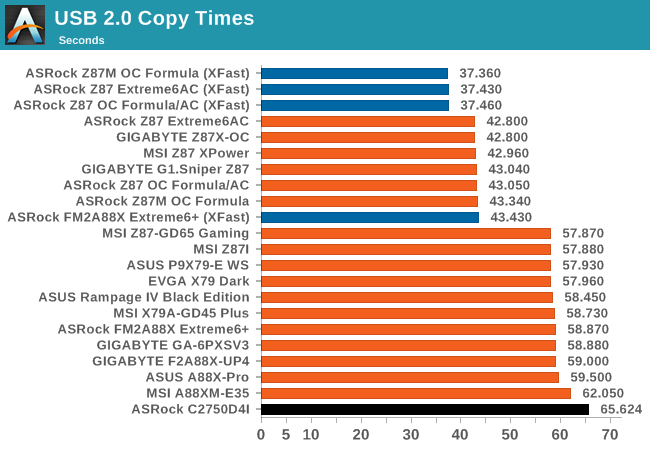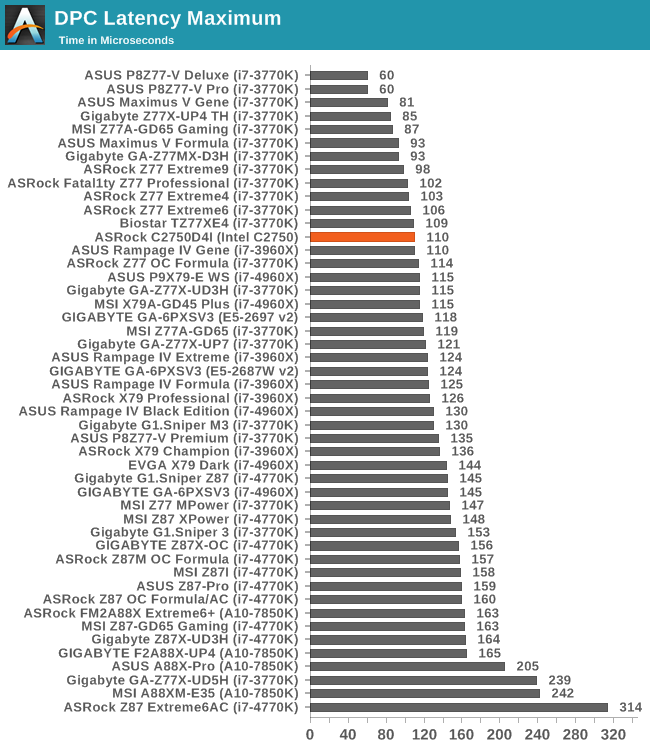ASRock Rack C2750D4I Review: A Storage Motherboard with Management
by Ian Cutress on April 29, 2014 9:00 AM EST- Posted in
- Motherboards
- Storage
- Atom
- ASRock
- Silvermont
- Enterprise
- server
- Avoton
System Benchmarks
USB Backup
For this benchmark, we run CrystalDiskMark to determine the ideal sequential read and write speeds for the USB port using our 240 GB OCZ Vertex3 SSD with a SATA 6 Gbps to USB 3.0 converter. Then we transfer a set size of files from the SSD to the USB drive using DiskBench, which monitors the time taken to transfer. The files transferred are a 1.52 GB set of 2867 files across 320 folders – 95% of these files are small typical website files, and the rest (90% of the size) are the videos used in the WinRAR test. In an update to pre-Z87 testing, we also run MaxCPU to load up one of the threads during the test which improves general performance up to 15% by causing all the internal pathways to run at full speed.

USB effectiveness is often limited by how quickly a system can turn on all the pathways for the required data, as well as the underlying chipset implementation. Avoton is not going to win any records today for USB speed, and the lack of a USB 3.0 port is an oversight.
DPC Latency
Deferred Procedure Call latency is a way in which Windows handles interrupt servicing. In order to wait for a processor to acknowledge the request, the system will queue all interrupt requests by priority. Critical interrupts will be handled as soon as possible, whereas lesser priority requests, such as audio, will be further down the line. So if the audio device requires data, it will have to wait until the request is processed before the buffer is filled. If the device drivers of higher priority components in a system are poorly implemented, this can cause delays in request scheduling and process time, resulting in an empty audio buffer – this leads to characteristic audible pauses, pops and clicks. Having a bigger buffer and correctly implemented system drivers obviously helps in this regard. The DPC latency checker measures how much time is processing DPCs from driver invocation – the lower the value will result in better audio transfer at smaller buffer sizes. Results are measured in microseconds and taken as the peak latency while cycling through a series of short HD videos - less than 500 microseconds usually gets the green light, but the lower the better.

While the system is not a digital audio workstation target, as our DPC test is quick and painless the results are included for completeness. The system actually does rather well, right in the middle of our Z77 testing.










85 Comments
View All Comments
SallyannePaoloniuic - Saturday, May 10, 2014 - link
Snayperskaya - Monday, May 12, 2014 - link
I know someone probably pointed this out, but running a default benchmark test against a system that is optimized to work on a dedicated role is a bit pointless. What about some data I/O tests on this one? I didn't see the test you guys take on HDDs/SSDs.trampsvondepalz - Monday, May 12, 2014 - link
I guess the main reason for this product launch is to attack the almost identically featured Supermicro Atom boards (like the A1SRi-2758F) at a somewhat lower pricepoint (which does not necessarily mean "cheap" ! ;-)Supermicro had almost no competitors in this very special segment before - or am I wrong there ?
Let´s wait and see if reliability and software support catch up with the grandmaster of storage & Server boards ! :-)
http://www.supermicro.nl/products/motherboard/Atom...
S.D.Leary - Tuesday, March 3, 2015 - link
I may have missed it, but did Ganesh ever test this board?SDLeary
NilamBhate - Thursday, April 16, 2015 - link
What is the 1U rack mount case - make and model you used here ?